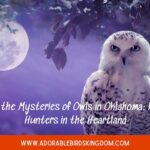If you’re like me, you’re fascinated by the diverse wildlife that calls North Dakota home. Among the most intriguing are the owls. These enigmatic creatures have long been a part of the state’s natural landscape.
In North Dakota, you’ll find a variety of owl species, each with its unique traits and behaviors. From the diminutive Eastern Screech Owl to the imposing Great Horned Owl, these birds are a testament to the rich biodiversity of the region.
Join me as we delve into the world of North Dakota’s owls. We’ll explore their habitats, their unique characteristics, and the role they play in the local ecosystem. It’s a journey that’s sure to captivate any nature lover or bird enthusiast.
Owl Species in North Dakota
When you dive deep into the species of owls found in North Dakota, it’s quite fascinating how varied they are. Not all folks know this, but there’s an impressive diversity of owl species found in this state, each carrying its unique traits and behaviors.
The Eastern Screech Owl, a small, camouflaged owl, is an innate master at hiding. Intriguingly, they’re known for their variety of vocalizations that can be heard during night-time. On the other hand, the Barn Owl, recognized by its heart-shaped facial disk, frequently nests in barns and other human-made structures offering an unmatched pest control service.
But the list doesn’t stop there. One of the larger species, the Great Horned Owl, known for its distinctive ear tufts or “horns,” stands as a dominant nocturnal predator. Speaking of large owls, let’s not forget the Snowy Owl, an iconic species typically found in North Dakota during winter months. Often seen on utility poles or fence posts, they’re easily recognized by their stunning, all-white plumage which makes them a local favorite. Furthermore, the Northern Saw-whet Owl, one of North Dakota’s smallest owl species, amazes bird enthusiasts with its size and elusive nature.
Each owl species has adapted well to their specific habitat, proving their strong survival skills in the distinct environment of North Dakota.
What mainly differentiates these owl species are their calls, plumage, size, and hunting techniques. Here’s a brief rundown:
| Owl Species | Call | Plumage | Size | Hunting Technique |
|---|---|---|---|---|
| Eastern Screech Owl | Variety of vocalizations | Grey/Brown | Small | Active mainly at night |
| Barn Owl | Screechy scream | Light gray with a white, heart-shaped face | Medium | Hunts in open fields and meadows |
| Great Horned Owl | Hooting sound | Large, brown with prominent “horns” | Large | Hunts at night, preys on a wide range of animals |
| Snowy Owl | Low, powerful hoot | White, sometimes with dark barring | Large | Hunts during the day, from a perch or the ground |
| Northern Saw-whet Owl | High, repeated toots | Brown with white streaks | Small | Nocturnal, hunts by waiting on a low perch |
Unique Traits and Behaviors of Owls
An exploration into the world of owls presents fascinating insights into their intriguing characteristics and behaviors. Let me share with you some of these captivating aspects of different owl species calling North Dakota their home.
One of the most distinctive traits of the Eastern Screech Owl is its exceptional vocal ability, often compared to a horse’s whinny or a long trill. That’s not all, their cryptic plumage, blending in seamlessly with tree bark, reflects perfect adaptation to woodland habitats. They provide a delightful auditory treat on summer evenings!
The Barn Owl is an undeniable farmer’s best friend. These owls consume a substantial amount of pests, offering great pest control. That’s a lot of mice! Some interesting reports suggest that a barn owl family can consume as many as 3000 rodents in a breeding season.
The Great Horned Owl, always brimming with dominance, sports distinctive, long ear tufts. Be prepared for some night-time spookiness as their deep-toned hooting is a traditional sound of the wild. Also, they’re apex predators, top of their food chain – a feat not common amongst many owl species.
Snowy Owls, the icons of winter brilliance, travel south from the Arctic to grace us during winter months. Their distinctive snowy-white plumage makes them easily identifiable. If you’re lucky, you may spot them resting on low-lying perches while they eye their next hunt.
Last, but surely not least, the elusive Northern Saw-whet Owls. These petite owls have distinctive white eyebrows – an unmissable feature. Oh, and that unique too-too-too call – it just adds to their charm.
Let me emphasize – looking for owls in North Dakota isn’t just about spotting birds. It’s about understanding their fascinating behaviors and characteristics and how they’ve adapted to thrive in their respective habitats. In the next section, we’ll delve deeper into the hunting techniques these owls employ, offering more glimpses into their world.
Habitats of North Dakota Owls
Diving into the dwelling places of these elusive creatures, we’ll find a sheer diversity of environments. The varied terrain of North Dakota offers a suitable home for all these owl species.
Eastern Screech Owls usually opt for woodlands, particularly near water. With their discreet plumage, they blend well into the bark of trees. They’re comfortable in suburban areas, often nesting in backyard trees or birdhouses.
On the other hand, the Barn Owl, staying true to its name, likes to nest in barns, abandoned buildings, or sometimes in trees. They prefer open fields and grasslands, prowling the night for unsuspecting rodents.
Great Horned Owls, known for their might, do not shy away from living close to humans. They prefer mixed forests or woodlands near fields, but can also be found in deserts, mountain regions, tropical rain forests, and even city parks.
The ghostly Snowy Owls, typically inhabitants of the arctic tundra, occasionally come as south as North Dakota during winter. They set up residence in open fields and coastal areas, providing a stark contrast with their bright white plumage against the snowy landscape.
Lastly, we have the Northern Saw-whet Owl, the elusive tenant of dense thickets. Preferring regions with heavy cover, they make their nests in coniferous forests, especially during their breeding season.
As we delve deeper into the lives of these owls, it becomes clear that their living preferences are as diverse as they are. Each species has a particular habitat suited best for their survival. This rich biological diversity is what makes the ecosystem of North Dakota a fascinating study of how nature flourishes under different conditions. Isn’t it astounding how North Dakota accommodates such diverse owl species in harmony?
With this insight into their habitats, let’s explore their hunting strategies. It’s intriguing how they employ unique techniques, using their adaptations to outwit their prey.
Role of Owls in the Local Ecosystem
Diving into the details, owls play a vital role in maintaining the ecological balance in North Dakota’s flora and fauna. Nicknamed nature’s pest control by some, these bird species prevent overpopulation of rodents and damaging insects.
Owls are primarily nocturnal hunters, and each species has its own distinctive technique. Take for instance, the Eastern Screech Owl with its excellent camouflage techniques. It’s almost invisible against the bark of trees, enabling it to surprise and snatch up unsuspecting prey. The Barn Owl, on the other hand, prefers to hunt in open fields, swooping down with silent precision akin to an ace sniper.
Marvel at the Great Horned Owl. With its exceptional hearing and large, wide eyes, it easily dominates various terrains, from woodlands to open prairies. But it doesn’t stop there. During North Dakota’s harsh winters, even the Snowy Owl is no stranger to the hunting game. This Arctic visitor can spot and seize prey hidden beneath layers of snow, showcasing nature’s stunning adaptability.
Next, let’s not forget the Northern Saw-whet Owl. Despite its smaller size, this species is no less a predator. Residing in dense thickets, these owls hunt smaller mammals and insects with guile and speed.
While the hunting prowess of these owls certainly earns our admiration, it’s their ecological role that truly underlines their presence in North Dakota. Predators like owls are necessary to keep a check on the population of rodents and insects, maintaining a balance in the ecosystem.
Notably, a single Barn Owl family can consume over 3,000 rodents in a single four-month breeding cycle. Delving into the statistics, if we take this one species alone the numbers are truly fascinating.
| Owl Species | Estimated Rodent Consumption |
|---|---|
| Barn Owl | 3000+ in four-month breeding cycle |
It’s vital to remember the importance of preserving these magnificent creatures and their habitats. After all, they do more than just hoot in the night – they’re the unseen heroes that keep our ecosystem balanced. Our next section will discuss this crucial topic in greater detail – the conservation efforts to protect these birds.
Conservation Efforts for North Dakota’s Owls
Recognizing the importance of owls in maintaining North Dakota’s ecological balance, multiple conservation efforts are in place. Environmental groups, government agencies, and volunteers are putting their best foot forward to help protect these species and their habitats.
The North Dakota Game and Fish Department is known to play a vital part in the process. They’ve developed various programs aimed at preserving owl habitats and promoting a better understanding of these fascinating birds. By conducting regular surveys, they’re able to track owl population trends and detect any significant declines in record time.
Efforts are not just limited to official bodies. Local volunteers play a key role in conservation work. Consider the case of the Northern Saw-whet Owl. Despite its small size, this owl species has a substantial effect on the local ecosystem. Conservationists utilize nest box programs to support these feathered predators. Volunteers build and install these boxes in strategic locations to provide a safe breeding space for the Northern Saw-whet Owl.
On top of habitat conservation, there’s also a great emphasis on public education. By making people aware of the ecological importance of owls and ways to protect them, I believe we’re fostering a more nature-conscious society.
Furthermore, integration of modern technology in owl conservation efforts is becoming increasingly prevalent. One example is the use of GPS tracking devices. They’re used to track flight patterns, to help scientists understand the owls’ habitat requirements and adapt their conservation strategies accordingly.
To give an idea, here is a breakdown of the owl species in North Dakota and the specific conservation efforts applied to each:
| Owl Species | Conservation Efforts |
|---|---|
| Eastern Screech Owl | Regular surveys, habitat preservation |
| Barn Owl | Nest box programs, habitat preservation |
| Great Horned Owl | Educational programs, habitat preservation |
| Snowy Owl | GPS tracking, habitat preservation |
| Northern Saw-whet Owl | Nest box programs, public education |
Beyond these efforts, there’s so much more that we could, and should, be doing to ensure the survival of these majestic birds. That’s food for thought as we continue this intricate dance with nature.
Conclusion
It’s clear that North Dakota’s owls are a vital part of the ecosystem and their conservation is a shared responsibility. The collective efforts of the North Dakota Game and Fish Department, environmental groups, and dedicated volunteers have made significant strides in protecting these birds. Yet, there’s always more work to be done. The use of modern technology and public education will continue to play a pivotal role in this endeavor. By understanding and respecting the habitats of different owl species, we can ensure their survival. It’s up to us to carry on these efforts and uphold North Dakota’s rich biodiversity. Together, we can make a difference for owls and the environment they call home.



